- Home
- Richard Powers
The Gold Bug Variations Page 9
The Gold Bug Variations Read online
Page 9
As Ulrich smoothly wraps up the Blue Sky session before it turns to Gray and Partly Cloudy, someone slips Ressler a note. More spectral theory, a spidery nineteenth-century hand:
Dr. Ressler—
Dismissals of verse notwithstanding, Fearless Leader harbors a closet predisposition to literature. Ulrich has contracted Poe’s Gold Bug. Communicable, I gather.
J.K.
The syntax seems a sequel to this session in cryptography. But the note, on second reading, begins to make marginal sense as plaintext. There already is a “J.K.” in the room; no need for letter substitution. Yet the note resists ultimate understanding. It doesn’t occur to him, as the brainstorm session breaks up, to ask the woman herself what she means. He watches her leave the room and looks again at the note, the first he’s received in twenty years of school. He follows Dr. Koss with his eyes across the lab and out the door. Monk Mendel’s chief lesson returns from first-year genetics: the rift between inner genotype and outer phenotype. Surfaces lie.
Back in his bachelor and still unfurnished flat, Ressler lies in his bunk at night, wrapped in the barrack walls, the cradling vacancy of his adopted town. The day’s stimulation prevents sleep. He runs through the proposed structure currently entrancing all biology except Woytowich and a few lone holdouts. The spiral molecular staircase—two paired railings sinuously twisting around one another, eternally unmeeting snakes caught in a caduceus—becomes in his fueled brain the stairs of Robeson’s spiritual: Jacob’s Ladder, the two-lane highway to higher kingdoms. Angels are caught descending and ascending in two solemn, frozen, opposing columns. In his soporific reverie, four kinds of angels twist along the golden stairs. Bright angels and dark, of both sexes. Four angel varieties freeze in two adjacent queues up and down the case, each stuck on a step that it shares with its exact counterpart. Every bright man opposite a dark woman. Every bright woman, a dark man. Fitful in his bunk, in the blackness, the unappeasable modelmaking urge. Four angel varieties to signify DNA’s four bases: thymine, cytosine, adenine, and guanine. Jacob’s helical staircase ladder conjured out of a single strand of nucleic acid.
How indispensable models have been in the fray to date! Watson and Crick did the trick with tin shapes, interlocking jigsaw pieces that refused to combine in any configuration consistent with the data except the spiral staircase. The great Pauling’s snips of accordion cardboard are an industry legend, an industry joke until laughter was hushed by the tool’s repeated success. Pauling’s children—molecular spheres and dowels—pop up in classrooms, raising a race of clear-eyed students whose innovative exhalations already warm Ressler’s neck. All the models agree: life science, to advance at all, cannot start with big and hope to pull it apart into underpinning little. It must begin with the constituents and tease them into a structure consistent with observation. Cyfer needs a model as simple and labile as baby blocks, a breathtaking Tinkertoy indistinguishable from the thing it imitates.
Four years ago Ressler, along with every other hapless haplotype, noticed that the double-spiral staircase embodies two identical informational queues. The ascending angel order complements and mirrors the descending stream. Wholly redundant. Each angel-file sequence can be entirely recreated from the other. Bright and dark men, dark and bright women: each pair-half uniquely mated, each edge of the staircase carrying the same message. All there in Crick and Watson’s tantalizing summary: “It has not escaped our notice that the specific pairing we have postulated immediately suggests a possible copying mechanism for the genetic material.” The angel-files in each half-stair must somehow be capable of latching on to their proper mates out of angelic bouillabaisse. Chemical lightning, sundering the staircase down its middle, unzipping it, creates two severed parades, each capable of recreating the entire original ladder. Ressler, in his bunk, has the wind knocked out of him by the ingenuity, the rightness of it: a long molecular chain, stupefyingly massive but simple, obeying nothing but chemical requirements, somehow lucks upon viability—the fundamental, self-replicating machine.
Stairway replication, an inanimate molecule’s ability to double, is just the tip of proliferate miracle. Somehow, incomprehensibly tortuously simply, coded in permutations of brights, darks, males, and females— four bases alone—is all the sequence needed to conduct the full angel choir. On this dream of spiral ladders, he lulls himself into brief, shallow sleep. Rest does not last long, nor does he wake refreshed. He is back in the stacks at opening, armed with the tip-off Jeanette Koss has passed him. He came to Illinois to crack the nucleic code. To date the only triplets he’s gone up against are Dewey Decimal. He looks up her clue in the card catalog: Poe’s “The Gold Bug.” Mystery, suspense: a story in a thousand anthologies. It’s been years since he’s read any fiction except the Oppenheimer charges. But the library jump-table leads him to 813 as easily as if he were a regular.
Squatting between two metal shelves, Ressler loses himself in the adventure. Discovery—a piece of heated parchment reveals secret writing. Pictograph of baby goat identifies author as Captain Kidd, language of cipher as English. Simple letter frequency and word-pattern trick leads scholar to pirate’s treasure. But directions to treasure are themselves a coded algorithm for unburying. Two men and blackfella servant, applying human ingenuity, measured paces, and plumb line, crack third-level mystery and uncover wealth beyond wildest dreams. Only at story’s end does he emerge, shake off the fictional spell. “Gold Bug” is the ticket all right; he’s come to the right place.
If he understands Dr. Koss’s warning correctly, Ulrich may be in danger of confusing the message of base-string sequences with their translation mechanism. Bulling through frequency counts and base-order mapping will never reveal a simple rule equating the impenetrable archive of nucleic rungs with hair color, hand length, texture of skin. The game is immensely bigger; much more than gene-reading is at stake. To search for sequence substitution, to pan for genetic gold bugs, would be tantamount to learning a foreign language armed with only a translating dictionary. They’d get no farther than a refinement of Morgan’s endless generations of Drosophila: chromosome bump X produces white eyes. A swap of one name for the other, no more than a means of reading individual messages without ever getting fluent in the tongue they’re written in.
The heart of the code must lie hidden in its grammar. The catch they are after is not what a particular string of DNA says, but how it says it. For the first time, it is possible to do more than wedge open the door. They must throw wide open the means of molecular articulation. They must learn, with the fluency of native speakers, a language sufficiently complex and flexible to speak into existence the inconceivable commodity of self-speaking. The treasure in Poe’s tale is not the buried gold but the cryptographer’s flicker of insight, the trick, the linguistic key to unlocking not just the map at hand but any secret writing. Ressler must bring the team to see that they are up against something considerably larger than the pleasures of the Sunday Crossword, fitting a few letters into empty boxes. Not the limited game of translation but the game rules themselves. Sprawled between the girders of the 800s, in the summer of his twenty-fifth year, he gets his first hint of the word puzzle he is up against. He must latch onto a language that can articulate its own axioms, a technique that can generate—in the effortless idiom it models—endlessly extensible four-letter synonyms for Life.
QUOTE OF THE DAY
When I left the library, I took my entire collection of index cards, the complete file of the three boards I’d established at the branch. The records would have disappeared long ago had I not squirreled them away in the first place. Still, the data theft will hurt more than a couple of old friends, who over the years have come to rely on my pocket score the way we all rely on Bowker or Wilson Line. Let them find their own materials. Yet by taking the card collection into custody, I’ve created my own problem. Squarely on my grandfather’s desk, a private encyclopedia of three-byfives cries out to be transcribed.
Any attempt to extract aff
idavit from these facts requires dirtying my hands. Franker, with his charming idiocy, liked to compare existence to a mound of potatoes: “You can’t proverbially mash ’em till they been proverbially skinned.” Information theory phrases the problem more elegantly but not as well. Yet the thought of putting my card hoard to account fatigues me beyond saying. A flood victim’s, a chemotherapy patient’s fatigue. July 15, 1985: I look over the options from the file, the day’s previous incarnations. One stands out from the cycle, one that positions me on the timeline.
I was no longer fresh in the field when I posted it. Much of the novelty of the job had worn off. But I was working full time, for myself, for achieved adulthood, for the sheer pleasure of work. The Event Calendar, my pride, had run smoothly for a couple of years. I posted everything from Savanarola to Synthetic Rubber, and people enjoyed the end results. In 1978, I took a small risk. I posted as canonical history an event only three years old. July 15, 1975: two spacecraft, each the peak technological achievement of two supernations, inimical enemies at ground level, take off from the earth. The enemy craft dock and join crews somewhere in the endless, frozen, neutral vacuum. The crews visit one another’s quarters. The coupled craft float soundlessly in orbit. Back on earth, everything is, for a moment, wonder.
The risk in posting this had nothing to do with going out onto a predictive limb. Beyond doubt the Apollo/Soyuz linkup, symbolically at least, was the equal of half the revolutions and three quarters of the assassinations that mark the usual mileage posts of progress. My risk was not in jumping the canonical gun. It lay in my four lines of accompanying caption—shriller than public servants were supposed to let themselves become. I held out the hope that the event had not come too late to save us from the rest of history. I announced, supported by facts I felt no need to produce, that we were pitched in a final footrace, not between Manichaean political ideologies but between inventiveness and built-in insanity. July 15 tipped the calendar ever so slightly toward the euphoric, exploratory. The risk I took was editorial, insisting that event was real.
This was years before I met Dr. Ressler and his clear-faced protégé. That same day, six years later, for a reason preserved in artifact, I posted, as quote of the day, Aristotle’s critique of the Pythagoreans in the Metaphysics: They say that things themselves are Numbers. The risk this time was entirely mine.
THE HUSBAND’S MESSAGE
For days after meeting Frank Todd for seafood—my dinner, his breakfast—I heard nothing from him. I’d turned up the facts; our business was transacted. But we weren’t done with one another. The flavor that kept coming back at odd hours as I fielded calls or directed question-traffic was the look that had come over my makeshift date’s face as I told him of Stuart Ressler’s disappointing early collapse. Todd had looked for an instant as if he were hearing, after the fact, the obituary of a childhood hero.
Time passed with no follow-up on Todd’s invitation to dig deeper. My job was to discard the content once I’d handed it over. In those few previous instances where professional assistance had aroused other interest, I’d always nipped it quickly in the stamen. Not that I felt any need to avoid temptation. Tuckwell had never demanded monogamy, at least not overtly. Keith referred to our commitment as a “Five-Year Plan” or a “Great Leap Forward”, depending on the humor his adwork left him in on a given day. If I steered a course of noninvolvement through daily contacts it was for my own sake: my research skill exceeded anything else I had to offer anyone. But Todd’s taciturn courtship, comical when delivered, confused me when withdrawn. I resented that professed infatuation with my face—sheer, male data—bribery. His semantic waffle over whether I was beautiful, a question more aesthetic than erotic, was simply clinical fascination for a woman who had him momentarily at her mercy.
I had wanted at dinner to preserve my informational advantage, to surrender the hard-won facts only at a favorable rate of exchange. But for some reason I still don’t understand, I gave in to pity, told him everything, bared my throat like low dog in a fight. I heard myself give him abstracts of every article I’d turned up. When all shred of danger to him had passed—one of those predators capable of remaining inert for hours as prey blunders blithely over it—Mr. Todd took the proffered parcel and was gone. My resentment kept doubling back on that moment when I’d caught him disconsolate, his confidence dropped. That quick glimpse of facial bruise told me he wanted something from me that had nothing to do with biographics. He needed what he would never know to ask for. It wrecked my equanimity: he requested less and went away satisfied.
When he called the Reference Desk again, he did not bother to identify himself. “Can we try this again? Same place and time? Round two?” I couldn’t imagine his motive in calling back. No hope of anything fresh, no new esoterica. I didn’t know whether to cut him or accept with pleasure. I went for a frosty yes.
I found the restaurant again, and Franklin Todd was waiting. I knew instantly the reason for this follow-up. I could tell from his posture, his welcoming grin. This date meant to erase whatever impression of weakness the first might have left. We were not to mention the case. We were to be absolutely upbeat. And afterwards, as befit cheerful strangers, never see each other again.
I confirmed that he was lamentably attractive, taller and sandier than I remembered, his light stubble two years ahead of fashion. He looked completely incapable of being devastated by the deterioration of an older coworker. But then, I did not then look like a woman capable of quitting her profession for nothing. He was in midsentence when I reached the table. “So what happened this morning?”
I was about to give the same, daily nonresponse I gave Tuckwell when, stopped by a sardonic crook to his face, I caught on. I returned the look, saying, “Spanish Civil War on the brink of breaking out, 1936. Goldwater wins GOP nomination, 1964. Apollo/Soyuz, 1975.”
He beamed. “You’re so predictable.”
I shook my hair loose and sat down. “You know, I haven’t even met you properly and already I don’t like you.”
“The pleasure’s mutual, I’m sure.” His face broke out in all the muted possibilities of the opening game. “You are extraordinary.” He gave the long word an extra syllable, intoning it with the same converted skepticism he had given his measurement of my beauty. “But you suffer from this terrible twentieth-century bias.”
“It’s not a bias. Most of what has happened happened in the last hundred years. Any newsworthy July day is probably recent.”
“I see. Current events, like traffic, increasingly clogged until one day soon some old guy’s going to pull out of his garage in Iowa and poof: universal gridlock.” He ordered for both of us, issuing instructions throughout the meal: “Squeeze the lemon like this. Let the taste sit on the back of your tongue while you think of Mardi Gras.” The imperatives carried the inbred, dictatorial drive of males—the hand in the small of the back they always use to steer the weaker vessel. But something else in his voice too: inappropriate enthusiasm for experience that needed sharing. Franklin in no way passed for a gourmet. He sniffed the Tabasco cap and made me do likewise. “Most expedient sinus recipe known to man.” He did not preach good taste so much as enjoyment. “Cut this end off. Swirl it first before dunking.” Expertise acquired over long trial and error, offered up now to save me the bother of the learning curve. It amused me, his assuming I’d never eaten food before. He had the ingenuous pleasure of a novice who sees in everyone a new initiate.
We paid and left. Coming out to the street, turning into the sidewalk tide, he took my hand and shook it enthusiastically, as if I’d been a far more entertaining guest than I had been. I was supposed to remember only this round, erase the unpleasant undertone of the first. I asked where he was headed. “My night off. Back home to the Butter and Eggs.”
“You live in Manhattan? What were you doing at our branch?”
“Research.”
“I was doing the research. You were humming to yourself, as I remember.”
�
��There’s a difference?” He smiled and left.
Another week went by before Franklin turned up again. I was cleaning out the Question Submission Box. To the query “I want to buy a microwave oven. Are they safe?” I knew both the desired answer and informed opinion. I’d been asked the question often, and I easily delivered the unimpeachable stats, adding at the bottom of my response, “Most reports concerning cooked human kidneys are urban legend.” Number two was “What is the formula for figuring compound interest?” or something as trivial. “Trivial”, I knew, derived from trivium, any junction of three Roman roads, where your basic whores hung out. I gave the formula with no editorial comment.
But the third note had been left for no one’s but my eyes. It was in the same anonymous typewriting as the one about making the catch. Todd had never had any intention of disappearing. He meant to water me with a steady stream of far-ranging, restless demands for answers for every imaginable issue, however far from hand.
Q:My friend and I (neither a crackpot in the ordinary sense) are in the middle of an ongoing argument that we’d like you to clear up. What is the possibility that we will someday communicate with life on other planets?
F.T., 7/19
I laughed out loud to read it. I spent the remaining afternoon answering as if this were itself an anonymous hello from deep space. Not that it took that long to compose my answer. I lingered, let myself down the luxury of unrelated alleys, the side paths research always opens up when one pays attention. The encyclopedia’s country lanes.
A:Serious scientific estimates about the possibility of contacting life on other planets are based on the Drake or Green Bank formula:

 The Overstory
The Overstory Bewilderment
Bewilderment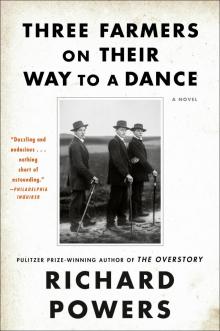 Three Farmers on Their Way to a Dance
Three Farmers on Their Way to a Dance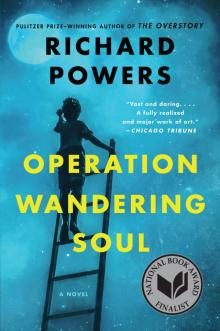 Operation Wandering Soul
Operation Wandering Soul Prisoner's Dilemma
Prisoner's Dilemma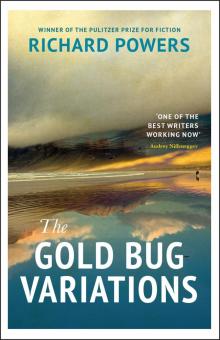 The Gold Bug Variations
The Gold Bug Variations Generosity: An Enhancement
Generosity: An Enhancement The Echo Maker
The Echo Maker Orfeo
Orfeo The Time of Our Singing
The Time of Our Singing PLOWING THE DARK
PLOWING THE DARK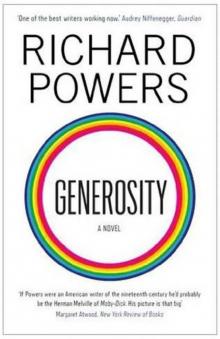 Generosity
Generosity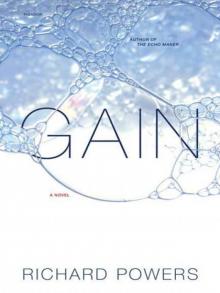 Gain
Gain